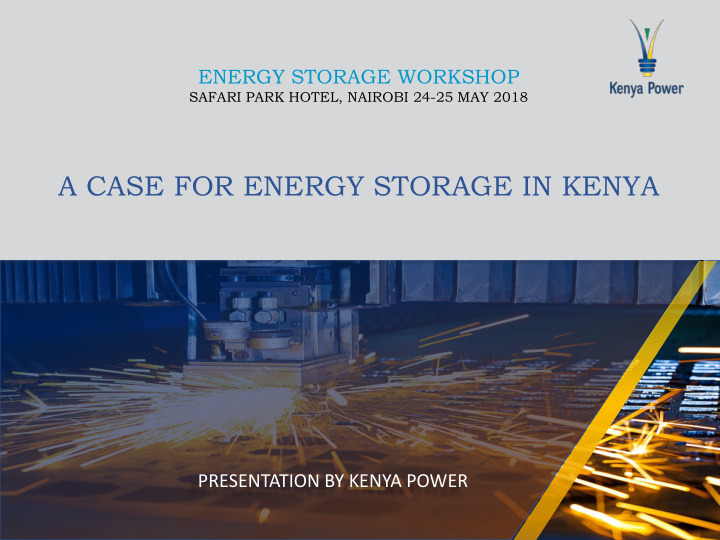



ENERGY STORAGE WORKSHOP SAFARI PARK HOTEL, NAIROBI 24-25 MAY 2018 A CASE FOR ENERGY STORAGE IN KENYA PRESENTATION BY KENYA POWER
ROLE OF KPLC Purchasing System Op Operator, bulk el bu electricity Di Dispatch fu function & sup supply (Sin (Single le Buy Buyer) Bu Build ilding an and Retailer of of El Electric icity Cu Customer mai aintaining a a rob obust Ser Service power ne po netw twork
ROLE OF KPLC Key stakeholder in: Procuring generation capacity: • • Demand forecasting Negotiate PPAs • • Generation planning Facilitate project development • • Transmission planning Facilitate operation of IPPs • Transmission planning 3
GENERATION CAPACITY AND ENERGY MIX • Geothermal currently provides about 47% of energy requirements. • Over 75% of country’s energy is supplied from renewable energy sources. • The installed capacity and generation mix contribution from wind and solar expected to grow from ongoing and planned projects. Generation Capacity Generation mix- April 2018 Projected Installed Capacity Mix 2023 0.00% 0.36% 8% 0.93% 19% 0.01% 10% 15.49% 11% 34% 35.41% 3% 47.80% 16% Hydro Geothermal Diesel Hydro Geothermal Wind Biomass Biomass Wind Solar Solar Thermal Imports Import
PEAK DEMAND AND LOAD CURVE 1,800 1,770 1800 1,754 1,780 1 ,768 1,760 1,727 1600 1,740 Peak Demand (MW) 1400 1,710 1,720 1200 1,700 1,665 1,680 1000 1,636 1,640 1,650 1,660 800 Load, MW 1,640 1,609 1,618 1,620 600 1,600 400 1,580 200 1,560 1,540 0 Time, Hr • • Current Peak demand is 1,770MW Peak demand falls between 6.00pm recorded on 17th January, 2018 and 10.00pm • • Projected demand growth rate of Off-peak period is between between 6% and 10% 12.00am to 05.00 am
ISSUES TO CONSIDER IN THE STUDY • Situation analysis -circumstances • Sizing of storage • Cost of storage and benefits compared to other options • Comparison with other technologies – GTs, pumped storage • Location of storage in the network • Functionality – primary or secondary reserves? • Best practices
RE & SYSTEM PLANNING CONSIDERATIONS • Integration of intermittent renewable energy and characteristics- solar, wind • LTWP requirements – single largest wind power plant Regulation/ load following capacity Base load capacity • Flexible generation plant – storage • Low or no variable cost capability • High capital/ fixed cost • Fast ramping capability • Geothermal, coal, hydro, non- • Low capital cost – lower utilization conventional renewable energy requirements plant - solar, wind, biogas etc. • Hydro, Gas turbines Peaking capacity Operating reserve capacity • Fast start-up and shut down • Primary reserve • Low capital cost • Secondary reserve • High variable cost • Tertiary reserve • Thermal (MSD), Gas turbines
RE GRID INTEGRATION CHALLENGES • Power system stability Frequency stability Load / generation imbalance Frequency variation • Transient stability Reduced system inertia (displacement of conventional plant) RE plants affected by system disturbances (disconnect during faults and voltage dips) Increased possibility of cascade of outages & loss of synchronism during system disturbances 8
ENERGY STORAGE PROJECT GOALS Provide Spinning Reserve to the system Stabilization of energy injection Supply Power profiles .i,e wind during Peak gusts, for output Load stabilization. To mitigate Reduce curtailment of Transmission RES production System curtailments Congestion when where there are production is constraints high.
SUCCESS INDICATORS FOR ENERGY STORAGE • A more stable system which survives large disturbances (loss of generators and loads) • Reduced load shedding – have sufficient capacity at peak • Reduced fuel consumption -running less thermal power plants during peak • Reduced load shedding – less transmission system constraints • Reduced system losses
Thank you
Recommend
More recommend